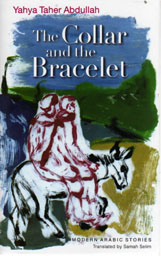Receive Our Newsletter
For news of readings, events and new titles.

The Collar and the Bracelet
by Yahya Taher Abdullah
Translated by Samah Selim
The American University in Cairo Press, Cairo / New York, 2008
ISBN 978 977 416 145 2, hbk, 146pp
The world of the Cairo story-teller
Yahya Taher Abdullah died in 1981 in his
early forties. He came from Upper Egypt, moved to Cairo where he led a vagabond
life, his writing being his sole source of income. He published five
collections of short stories and four novellas. Political activities led to his
imprisonment and his writings reflect an acute social concern for the
marginalised. Denys Johnson-Davies translated one collection of his stories,
entitled The Mountain of Green Tea. This second volume is most welcome.
The collection contains a novella and a
baker's dozen of short stories, some very short, the shortest being little more
than a hundred words. The novella tells the story of three generations of the
life of a family in a south Egyptian village. The young man is away for many
years as a migrant labourer in Sudan and Palestine (before 1948), sending
occasional remittances back home. His sister marries and has a daughter who
dishonours the family and has to be killed by her uncle. The family's world is
restricted by rigid convention, illiteracy and geographical isolation. The
story is told with an economy of words, in a staccato way, with short chapters,
themselves divided further.
The short stories are located mostly in Cairo. They are
tales of alienation, dislocation, the struggle for survival in a harsh
environment. "The Song of Elia the Lover" is about a lonely Saidi wandering
around Cairo, dreaming about a girlfriend whose father, and so his family, has
been exiled to the far south by his employers for insolence to his boss. 'Mr
Sayyid Ahmad Sayyid' tells of another dreamer, an older man, in arrears for the
rent of his one room, obsessed by reading, of all things, Bonaparte in Egypt by
J Christopher Herold.
It comes as no surprise to learn that
Abdullah used to recite his stories to literary gatherings, for the story
appeals to the ear rather than to the eye. The translator has succeeded in
transferring this stylistic feature into English. There is a translator's
Afterword in which she explains some of the problems and challenges of translation.
She has splendidly met the challenge.
From Banipal 33 - Autumn/Winter 2008
Back to top